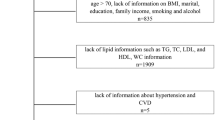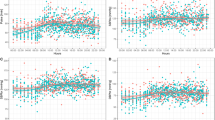Abstract
Erectile dysfunction (ED) may be an early sign or symptom of cardiovascular disease (CVD). We examined the relation of traditional and emerging risk factors for CVD to the severity of penile vascular disease in men with ED and without clinical coronary artery disease (CAD). In total, 137 men with ED were evaluated for penile vascular disease severity by penile Doppler ultrasound. These men were divided into the following groups based on ultrasound results: normal, cavernous venous occlusive disease, mild arterial insufficiency, and severe arterial insufficiency. Traditional (fasting lipid panel, fasting glucose, age, BMI, smoking, Framingham coronary artery disease risk score) and emerging (C-reactive protein, Lp(a), homocysteine) risk factors for CVD were correlated to severity of penile vascular disease in men with ED and without clinical CAD. Using univariate analysis, penile Doppler groups showed significant positive correlation to CRP (r=0.21; P<0.05) and age (r=0.30; P<0.01). For CRP, this correlation remained significant even when adjusted for age (P<0.05). Men displaying evidence of penile arterial disease (mild and severe arterial insufficiency) were characterized by elevated CRP levels (0.17 mg/dl) compared to men with no evidence of arterial abnormalities in the penis (0.04 mg/dl). CRP levels correlate significantly with increasing severity of penile vascular disease as measured by penile Doppler.
This is a preview of subscription content, access via your institution
Access options
Subscribe to this journal
Receive 8 print issues and online access
$259.00 per year
only $32.38 per issue
Buy this article
- Purchase on Springer Link
- Instant access to full article PDF
Prices may be subject to local taxes which are calculated during checkout



Similar content being viewed by others
References
Feldman HA et al. Impotence and its medical and psychosocial correlates: results of the Massachusetts Male Aging Study. J Urol 1994; 151: 54–61.
Morley JE et al. Relationship of penile brachial pressure index to myocardial infarction and cerebrovascular accidents in older men. Am J Med 1988; 84: 445–448.
Chung WS, Shim BS, Park YY . Hemodynamic insult by vascular risk factors and pharmacologic erection in men with erectile dysfunction: Doppler sonography study. World J Urol 2000; 18: 427–430.
Virag R, Bouilly P, Frydman D . Is impotence an arterial disorder? A study of arterial risk factors in 440 impotent men. Lancet 1985; 1: 181–184.
Shabsigh R, Fishman IJ, Schum C, Dunn JK . Cigarette smoking and other vascular risk factors in vasculogenic impotence. Urology 1991; 38: 227–231.
Kawanishi Y et al. Screening of ischemic heart disease with cavernous artery blood flow in erectile dysfunctional patients. Int J Impot Res 2001; 13: 100–103.
Ridker PM . High-sensitivity C-reactive protein: potential adjunct for global risk assessment in the primary prevention of cardiovascular disease. Circulation 2001; 103: 1813–1818.
Knoll LD, Abrams JH . Evaluation of penile ultrasonic velocitometry versus penile duplex ultrasonography to assess penile arterial hemodynamics. Urology 1998; 51: 89–93.
Broderick GA . Evidence based assessment of erectile dysfunction. Int J Impot Res 1998; 10(Suppl 2): S64–S73.
Metro MJ, Broderick GA . Diabetes and vascular impotence: does insulin dependence increase the relative severity? Int J Impot Res 1999; 11: 87–89.
Grundy SM et al. Assessment of cardiovascular risk by use of multiple-risk-factor assessment equations: a statement for healthcare professionals from the American Heart Association and the American College of Cardiology. Circulation 1999; 100: 1481–1492.
Rosen RC et al. Development and evaluation of an abridged, 5-item version of the International Index of Erectile Function (IIEF-5) as a diagnostic tool for erectile dysfunction. Int J Impot Res 1999; 11: 319–326.
Friedewald WT, Levy RI, Fredrickson DS . Estimation of the concentration of low-density lipoprotein cholesterol in plasma, without use of the preparative ultracentrifuge. Clin Chem 1972; 18: 499–502.
Roberts WL et al. Evaluation of nine automated high-sensitivity C-reactive protein methods: implications for clinical and epidemiological applications. Part 2. Clin Chem 2001; 47: 418–425.
Pasceri V, Willerson JT, Yeh ET . Direct proinflammatory effect of C-reactive protein on human endothelial cells. Circulation 2000; 102: 2165–2168.
Fichtlscherer S et al. Elevated C-reactive protein levels and impaired endothelial vasoreactivity in patients with coronary artery disease. Circulation 2000; 102: 1000–1006.
Venugopal SK et al. Demonstration that C-reactive protein decreases eNOS expression and bioactivity in human aortic endothelial cells. Circulation 2002; 106: 1439–1441.
Jarvisalo MJ et al. Elevated serum C-reactive protein levels and early arterial changes in healthy children. Arterioscler Thromb Vasc Biol 2002; 22: 1323–1328.
Wallenfeldt K et al. Carotid and femoral atherosclerosis, cardiovascular risk factors and C-reactive protein in relation to smokeless tobacco use or smoking in 58-year-old men. J Intern Med 2001; 250: 492–501.
Mendall MA et al. C-reactive protein: relation to total mortality, cardiovascular mortality and cardiovascular risk factors in men. Eur Heart J 2000; 21: 1584–1590.
Author information
Authors and Affiliations
Corresponding author
Rights and permissions
About this article
Cite this article
Bank, A., Billups, K., Kaiser, D. et al. Relation of C-reactive protein and other cardiovascular risk factors to penile vascular disease in men with erectile dysfunction. Int J Impot Res 15, 231–236 (2003). https://doi.org/10.1038/sj.ijir.3901012
Received:
Revised:
Accepted:
Published:
Issue Date:
DOI: https://doi.org/10.1038/sj.ijir.3901012
Keywords
This article is cited by
-
The Gut Microbiome and Men’s Sexual Health
Current Sexual Health Reports (2019)
-
Relationship between erectile dysfunction and the neutrophil to lymphocyte and platelet to lymphocyte ratios
International Journal of Impotence Research (2018)
-
Restorative effect of resveratrol on expression of endothelial and neuronal nitric oxide synthase in cavernous tissues of chronic unpredictable mild stress-exposed rats: an impact of inflammation
International Journal of Impotence Research (2018)
-
Chronic Rhinosinusitis Associated with Erectile Dysfunction: A Population-Based Study
Scientific Reports (2016)
-
Occurrence of erectile dysfunction, testosterone deficiency syndrome and metabolic syndrome in patients with abdominal obesity. Where is a sufficient level of testosterone?
International Urology and Nephrology (2012)



